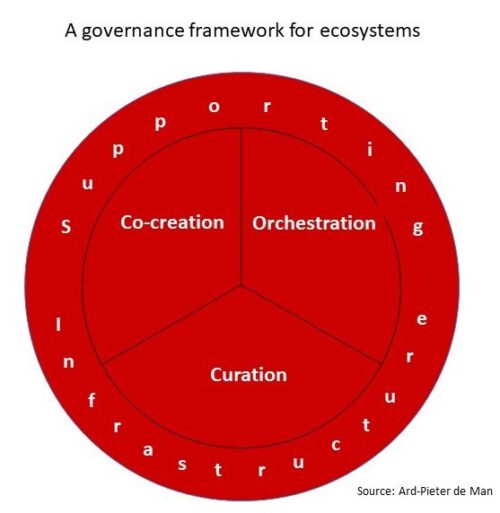Platform ecosystems (4): A governance framework for ecosystems
This is part three of seven blogs on platform ecosystems. All blogs can be found on Blogs – Organizational Revolution
With thousands of parties active on a platform: how do you govern your ecosystem? In previous blogs I explored the challenges of managing ecosystems and the techniques to deal with them. I explained that curation of the partner ecosystem is one of the keys to effective ecosystem governance. The figure below presents an overall framework for the governance of platform ecosystems. Four elements require attention.

Orchestration defines the playing field and the rules of the game of the ecosystem. It specifies the desired direction of the ecosystem, its scope and the conditions partners need to comply with when working with the platform. The scope consists of the regional, technological, functional or market areas in which partners are sought. The conditions define the business models, decision-making mechanisms and the norms and values partners need to adhere to. These conditions should enable partner interaction with the platform and the interaction among partners. Platform owners can signal change by adapting the direction, scope and conditions. Whether their partners are willing to comply with such changes is not in their hands: platform owners have no full control over their ecosystem.
Curation refers to the selection/attraction, organizing, and removal of individual players on the platform within the context determined by the orchestration activities. So where orchestration is about the playing field and the rules of the game, curation is about the individual players. Who do you want in your ecosystem? How would you like them to behave? As shown in my previous blog, many mechanisms are involved in this (see the blog here: https://bit.ly/3w3GGGx). Note that individual players also may need to be removed: partners that do not adhere to the platform rules may undermine the platform. Also note that platforms can be very restrictive in the amount of players they allow to participate or can be very generous in giving players access. Striking the balance between open and closed requires some skill. A later blog will deal with that question.
Co-creation is about the act of joint innovation with players in the ecosystem. Co-creation can occur in three ways. The first occurs between the platform owner and one or more ecosystem partners. The second occurs when the platform acts as a matchmaker and connects two or more players and next lets them innovate together. The third occurs when partners find each other on the platform without the intervention of the platform owner. The continuous creation of new value propositions that follows from this will keep the platform relevant to both customers and partners.
The supporting infrastructure exists of the technologies and organizational activities that support the orchestration, curation, and co-creation. The tangible aspect of the supportive infrastructure is the platform consisting of databases, algorithms, application programming interfaces (apis), and software development kits (sdks) that enable partners to interact with the platform. The organizational infrastructure consists of the people involved in managing the ecosystem. Booking.com for example employs people who visit hotels to learn how hotels use Booking.com and how their customer journey can be improved (see the full description of Booking.com in this book: https://amzn.to/2PApjw4).
The governance concept is a circle to indicate that developments in ecosystems are non-linear. Ecosystems don’t start with orchestration, next start curating the network and end with co-creation. In reality all three processes take place at the same time. Co-creation may open up a new field of innovation that automatically attracts new partners and next requires changes in the orchestration or the supporting infrastructure to really profit from the new opportunity.
This governance framework does not only apply to platform ecosystems. I have also applied it to value proposition based/innovation ecosystems and business ecosystems. The nature of the four elements in the framework differs dramatically depending on the type of ecosystem You can find more information about this in an article I wrote for the Alliance Quarterly: https://bit.ly/3u3AzQB. Did you pay attention to all four elements of the governance model?
About this series
In a series of seven blogs I give my view on the ins and outs of managing platform ecosystems. I will discuss the four challenges of managing platform ecosystems, what companies do to overcome the challenges, a model for the governance of platform ecosystems, modelling ecosystems through value maps, how value proposition based ecosystems relate to platform ecosystems and when to opt for a closed or open ecosystem.
All blogs can be found on Blogs – Organizational Revolution
